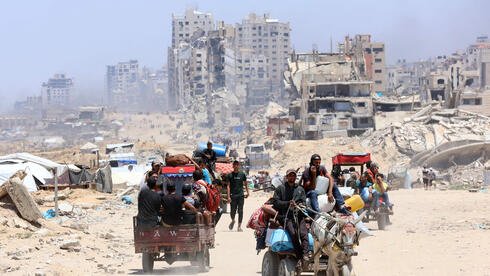Ostensibly, it is a gesture of humanitarian responsibility. But as the scope and budget of the project become clearer, a different picture emerges: one where compassion collides with fiscal risk, sovereign credit ratings and the fragile mechanics of macroeconomic credibility.
The initial price tag? Between 10 and 15 billion shekels (approximately $2.7-$USD 4 billion. In a nation still absorbing the financial shockwaves of the October 2023 war and scrambling to rebuild devastated northern towns, that figure is not a footnote; it’s a headline. The budget allocation, according to senior officials quoted in the Israeli press, may fall squarely on the Israeli taxpayer, with little expectation of foreign underwriting. And while the government frames this as a strategic investment in regional stability, the numbers beg a different question: can a country already teetering on the edge of a credit downgrade afford to absorb a project of this magnitude?
To put things in perspective: Israel’s annual state budget in 2025 is projected at roughly 610 billion shekels. The proposed humanitarian city would consume between 1.6% and 2.5% of that total, comparable to the annual budget of the Ministry of Transport. But unlike infrastructure spending, which offers a clear return on investment through productivity gains and long-term tax receipts, this project has no economic multiplier. It is a humanitarian buffer zone with a geopolitical purpose but no fiscal feedback loop. Every shekel invested is a sunk cost.
Worse still, the proposal arrives at a time when Israel’s macroeconomic position is already under strain. The national debt has grown substantially since the October war, crossing 70% of GDP for the first time in years. Military spending has increased by 15% year-on-year, while social compensation programs for evacuees, reservists and displaced businesses remain in full swing. The country’s fiscal deficit is widening; the Bank of Israel has warned of inflationary pressures if spending continues unchecked. And the international credit rating agencies, Moody’s and S&P among them, have already downgraded Israel’s rating in 2024, citing political instability, regional escalation and unsustainable fiscal expansion.
The humanitarian city, therefore, is not simply a budget item. It is a signal. And in economics, signals matter as much as outcomes. A government that channels billions into an open-ended, politically sensitive, diplomatically unbacked project is broadcasting volatility, precisely the trait that bond markets punish. Should Israel move forward with full financing of the project, analysts anticipate a negative revision in credit outlook, even if a formal downgrade is postponed. The cost of borrowing will rise. Bond yields will reflect heightened risk. And the impact will trickle into the domestic economy via higher mortgage rates, tighter credit and constrained capital for small businesses.
One could argue that moral imperatives trump budgetary constraints. That is a defensible position in wartime. But even the most noble gestures must be measured in terms of sustainability. Without a multilateral framework, UN involvement, Arab League endorsement, or at minimum, Western fiscal participation, Israel risks shouldering the entire burden alone. There are whispers of American or Emirati interest, but no binding commitments. And without external partners, the entire project is exposed to the political winds of Jerusalem.
 Dr. Bella Barda Barkat Photo: Lia Yaffe
Dr. Bella Barda Barkat Photo: Lia YaffeMoreover, the structural uncertainties of the plan are troubling. Who governs this city? What legal framework applies? Who provides security? Will residents be allowed to return to Gaza, or is this a permanent displacement? Every unanswered question adds risk. From a governance perspective, the idea of allocating billions to a civilian population that lacks citizenship, under ambiguous jurisdiction, with no parliamentary oversight, is a fiscal anomaly and a constitutional grey zone.
Some supporters of the initiative tout its strategic logic: separating civilians from combat zones, reducing international pressure and laying the groundwork for a post-war political settlement. Yet these are strategic hopes, not economic plans. Hope, history reminds us, is a poor substitute for liquidity.
Ultimately, the humanitarian city is not just a logistical question of where Gazans might sleep. It is a reflection of how Israel sees its financial future. Will the state continue to expand spending through exceptional one-off projects, straining its fiscal envelope? Or will it begin to reassert discipline, prioritize domestic reconstruction and seek external alliances for high-risk initiatives?
In the global economy, states are judged not only by the righteousness of their intentions but by the resilience of their balance sheets.
Israel’s leadership may believe it is building a moral ark in the desert. But to the bond markets, it may look more like a fiscal mirage.




